After a deadly crash, Sacramento fixed a dangerous road. Why isn’t this the norm?
On the last night of his life, Larry Horton hurtled down Broadway, launched his silver car over a line of solid protective posts and slammed into a first-floor office.
The wreck left Horton, 64, dead at the intersection of Broadway and Martin Luther King Jr. Boulevard on Nov. 30, 2021. A few months later, the coroner’s report used a word that absolved everyone of wrongdoing: “Accident.”
And yet the city had also expected that something like this would happen. That’s why the posts had been installed right in front of the entrance of St. Hope, an umbrella organization that oversees other nonprofits in Oak Park. Drivers kept crashing into the building.
A car crash at the Oak Park intersection resulted in a severe injury in 2019. Cassandra Jennings, the president and CEO of St. Hope, said that when she started her job at the non-profit in 2021, “Our office space had been hit twice.”
The city has plans make Broadway safer, partly by removing one lane in each direction so drivers would be forced to slow down.
The road is dangerous.
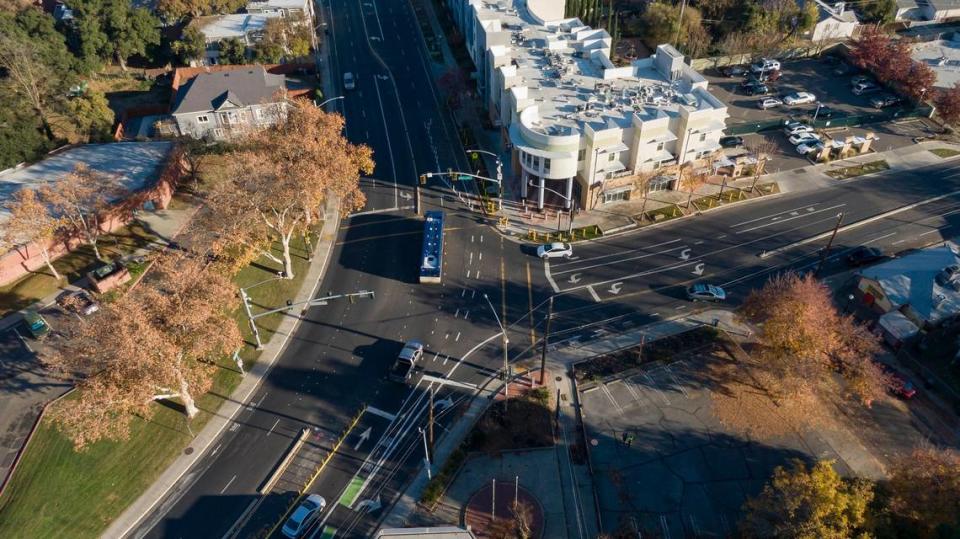
Sure, Horton was in the driver’s seat. But the intersection — where a wide section of Broadway suddenly tacks at about a 120-degree angle from heading southeast to heading east — shouldn’t have looked like that. And even though the office was not occupied when the car rammed inside, vulnerable people were in the building. St. Hope is on the ground floor of an apartment complex for seniors.
In response to that crash, by the summer of 2023, Broadway and MLK had been transformed. Through-traffic heading eastbound on Broadway is now funneled into one lane starting two blocks before the intersection. Stick-bollards — thin plastic posts — set off a bike lane to the right and narrow the lane to the left. The way that city engineers tapered the space for cars, with paint and plastic stick-bollards, coaxes drivers to slow down as they head into the curve.
These changes were relatively low-cost interventions known as “traffic-calming” measures. All of it cost $60,000. The paint and the plastic and the signs weren’t the most permanent or the most effective, but they were an enormous improvement. The original design of the road made it more dangerous by encouraging drivers to speed up; the physical changes made it safer by encouraging them to slow down. The city could easily control one thing about the crash: the shape of the road Horton drove.
Pedestrians, cyclists and drivers, as well as people who live or work in the St. Hope building, are safer now. The city’s bureaucracy took a relatively short amount of time to make improvements after the fatal crash. But that timeline — and the funding to make it happen — were the exception.
At the end of May 2023 — a year and a half after Horton’s fiery death in Oak Park — two children and a young mother died after a car wreck on a curve in San Juan Road, another stretch of Sacramento infrastructure known to be hazardous. Rayshawna Armstrong, 25, and her 3-year-old son, Zayden, were killed by the Northgate crash, along with 5-year-old Alex Leon. Armstrong’s daughter, Lajayla, and seven other children in the car as well as the driver, Precious Dawn Flowers, were severely injured.

Flowers was charged with three counts of vehicular manslaughter in June.
Too many people were in the car, and Flowers was driving. It was her fault.
Still, just a few feet from the oak that she crashed into, a driver hit a light pole and a tree and died in the winter of 2017. Between 2011 and May 2023, at least six cars collided with “fixed objects” — likely the trees or light poles on the south side of the curve.
Marbella Sala, president of the Gardenland Northgate Neighborhood Association, said in June that neighbors had been complaining to officials that the road is dangerous for years.
Their complaints have not yet led to tangible change. Since May, the city of Sacramento has done no safety-enhancing work on the road.
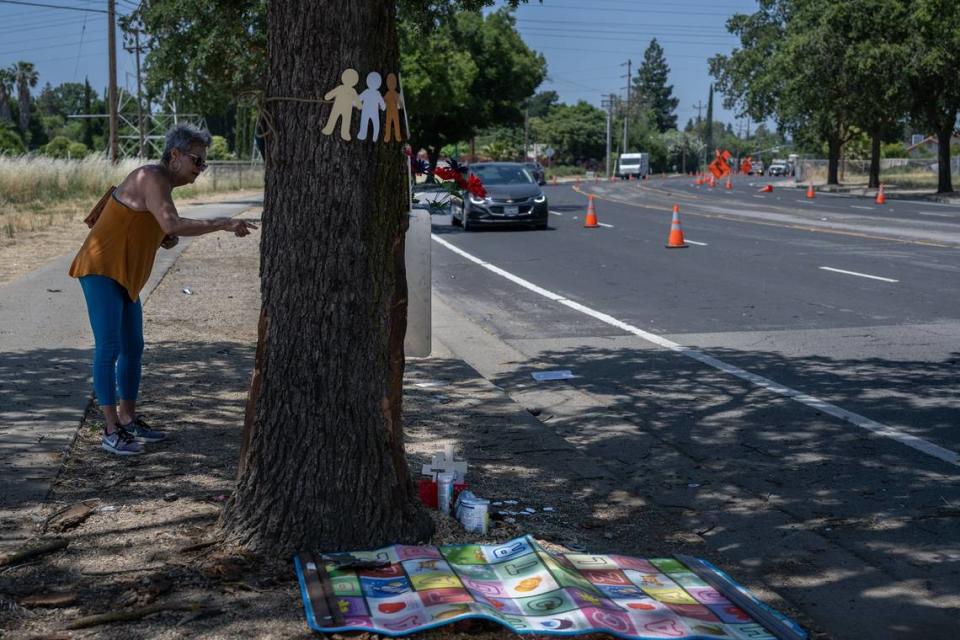
The lack of urgency bothers Armstrong’s older sister, Keyona Travis. It seemed to her as though her sister — who she referred to as “the Chihuahua of the family” because she was petite but fierce — had faded away. Armstrong’s son, Zayden “Zay Zay” Mangram, was a bubbly toddler. After the crash, Armstrong’s daughter, Lajayla, was in the hospital for weeks; she’s now 7, and being raised by her grandmother.
They had been a close family. The sisters and their children — Travis has four of her own — lived together at the time of the crash. Of the little boy, Travis said, “I never really called him my nephew.”
She didn’t call him her nephew because she saw him, she said, as “more my child.”
She lived across the street from the crash site a few years ago, and she’s seen cars speed down the roadway. “I really hope that they either put a bump right there to prevent vehicles from speeding,” Travis said, “or a stop sign will be good, or something to add in that curve to get people to slow their vehicles down.”
On Tuesday, the City Council representative for the district, Karina Talamantes, successfully lobbied the council to transfer $90,000 in transportation funds to start the planning and permitting phase for a Niños Parkway safety project that crosses San Juan Road. With the funding, city staff will sketch out a pedestrian refuge island at the curve in the street, as well as a pedestrian warning signal.
The Niños Parkway improvement plan was first approved in 2004, 19 years before the fatal wreck in May.
The only immediate response to the crash was a criminal prosecution. Flowers, the driver, is the sole person who’s been held accountable for the deaths. She remains in jail.
Change the approach
Experts say that that approach — placing all the blame squarely on the driver — is part of what’s left the U.S. with its staggering numbers of car wreck deaths in the first place. Other approaches prove that the vast majority of these deaths are preventable.
“We’ve seen from other countries, particularly in northern Europe, that they’ve gotten so close to actually having zero traffic fatalities,” said Kari Edison Watkins, a UC Davis professor of civil and environmental engineering. “We know it’s possible, right? There are places where they’re designing (infrastructure) in ways that they’re getting pretty darn close to zero.”
Though other largely preventable deaths — particularly deaths caused by violent crime — receive far more attention, Sacramento’s crisis of road fatalities has worsened over the last decade. According to UC Berkeley’s Transportation Injury Mapping System, in 2013, a total of 43 people were killed by car wrecks in the city. In 2022, 73 fatal car crashes on Sacramento roads left 78 people dead. Of those, seven were cyclists, and 36 were on foot.
Fixing the roads that have left so many injured and dead, however, is not a funding priority for the city. Sacramento politicians and city staffers are left to scramble for the resources to make improvements.
Because despite the crisis — and the mounting deaths — virtually no money is earmarked for street safety projects in the city budget.
Dearth of money
In January 2017, Sacramento officials adopted a “Vision Zero” plan to eliminate traffic fatalities and serious injuries by 2027.
In the year of the Vision Zero announcement, Berkeley’s Transportation Injury Mapping System reports, 66 people died in car crashes in the city. Over the following five years, 289 people died.
Despite the goals, projects are unfunded.
“We have no money to be able to fund small projects like the one that I want to see investment in,” said Talamantes. “City staff does a great job applying for federal and state dollars for public infrastructure, but we are constantly competing against other jurisdictions.”
She has been working with city staff to assess whether they can build a roundabout on San Juan Road. She aims to to make the curve less dangerous after the fatal crash that killed Armstrong and two young children in May, but, she said, funding is a huge hurdle. It took her almost eight months to secure the $90,000 that was finally approved Tuesday for, among other things, planning a pedestrian refuge. That relatively small amount of money will jump-start a plan that has been in the works since 2004. Staff, she said, “constantly” spend time applying for grants.
Sacramento has more than 700 planned projects to improve the transportation network, said Gabby Miller, a spokeswoman for the city. Those projects, she said, would cost more than $5 billion.
“We don’t have that level of funding available,” Miller said.
In the last fiscal year, Miller said, staff in the Engineering Services Division chased after nearly $200 million in grants.
They received $38 million.
Talamantes has lived in the district she represents — which covers Natomas, Northgate and Gardenland — for years. She frequently drives down that same part of the road where two children died and another seven were severely injured. She said that she was fed up with the status quo: “Our community, when I hear their frustrations about that road being unsafe, I feel the same way.”
Twist and turns in plans
Facing a staggering lack of funds, the city has come up with a triage system.
The Transportation Priorities Plan lists three projects on San Juan Road. One is a buffered bike lane that spans just one block (medium priority); one is to improve the intersection as well as signage and striping around Natomas High School (medium priority); another, farther west, would add sidewalks, bikeways and new landscaping over about half a mile of the street (lower priority).
The two medium-priority projects are west of the curve, within a mile, and might slow down traffic if they were implemented.
In the meantime, the posted speed limit is 40 mph. The San Juan curve winds through a residential neighborhood full of children and a city park. Some traffic studies assume drivers are going 50 mph.
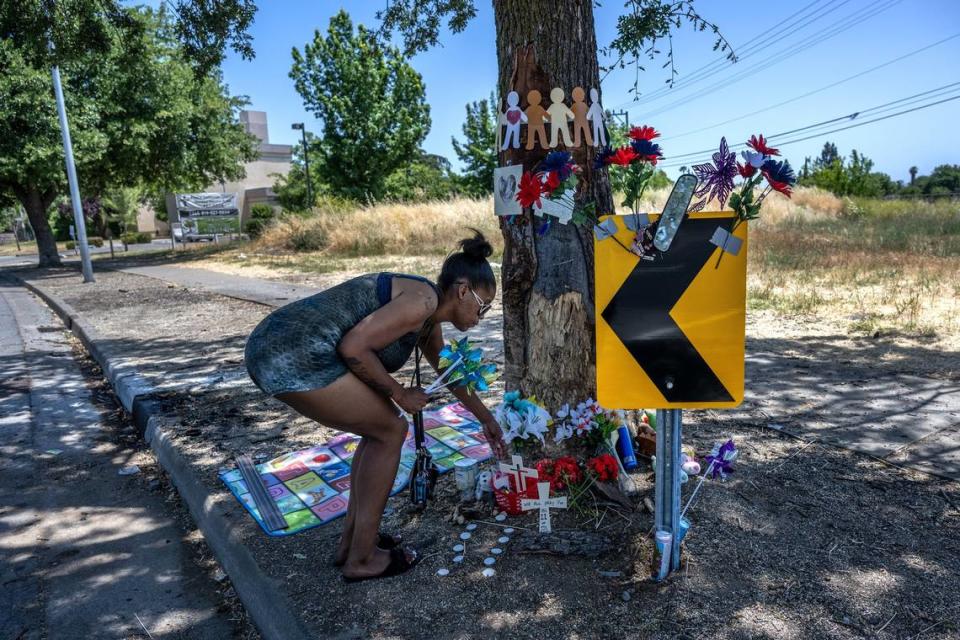
According to the AAA Foundation for Traffic Safety, the average risk of death for a pedestrian hit by a car traveling at 42 mph is 50%; when cars are traveling at 50 mph, the risk of death is 75%. If the impact speed is 23 mph, by contrast, the average risk of death is 10%. And the bigger the car, the more likely it will kill someone.
Talamantes wants a roundabout built to force drivers to slow down as they go through the curve. The road currently has two lanes of traffic in each direction, plus a center turn lane. Talamantes wants to try to narrow the road to one lane in each direction, which would also force cars to slow.
“Transportation and just pedestrian safety, it’s a big concern for the city of Sacramento,” she said. “That’s something that we as a city need to continue to figure out: how to slow down traffic.”
How to slow down traffic is clear. Evidence shows that raised crosswalks, speed bumps, narrower roads and, in particular, car lanes reclaimed for cyclists, pedestrians and landscaping are effective methods for forcing drivers to slow down, thereby making communities healthier and safer.
But how to pay for better streets is a trick the city of Sacramento hasn’t figured out. Presently, Miller said, the city has a $298 million “backlog” just for road maintenance costs.
Solutions, but no money for them
“You’re gonna hear me say ‘crash’ instead of ‘accident,’” said Watkins, the UC Davis professor who studies transit. “If somebody is speeding, the roadway is telling them it’s OK for them to speed.”
The professor explained that research shows wide streets — such as San Juan Road currently, and that section of Broadway before the bollards and new paint went in — encourage drivers to speed.
“The goal is to not have any crashes,” she said. “But if we’re gonna have some, we want to make sure that people are walking away from them. The best way to do that is to decrease those speeds, so if we can make the lanes narrower, it’s going to have that effect.”
The most effective solutions, Watkins said, are physical changes, including solid vertical barriers, that make speeding, and consequently hitting pedestrian and cyclists, much harder for drivers. But flimsier interventions such as those now in place at Broadway and MLK are still decent.
Even getting those less-than-ideal changes is a slow process. “In terms of bureaucracy,” said David Moore, a project coordinator at the infrastructure advocacy group Civic Thread, “it takes a lot of time and a lot of political and community willpower.”
That community willpower generally has to come from disempowered corners: Dangerous roads in Sacramento County are concentrated in low-income communities of color, and the people who face the greatest risk are Black.
The process to get these roads fixed starts, often, with terrible problems.
Generally, Moore said, transportation planners will learn of a problem, and alert the relevant City Council member; the planners will ask City Council for permission to apply for grants to plan a solution to the problem; if they get a grant, the planners will produce a report which includes feedback gathered from neighbors. Then, he said, city engineers take the report and look at the physical possibilities of the space, and create a plan from the engineering side.
David Edrosolan, the city traffic engineer who oversaw the improvements at Broadway and MLK, said he sends investigators to look at areas that draw complaints.
“The first step is we’re looking for, let’s just call it the low-hanging fruit, the low-hanging safety items that we can implement,” he said. “These are low-cost stuff.”
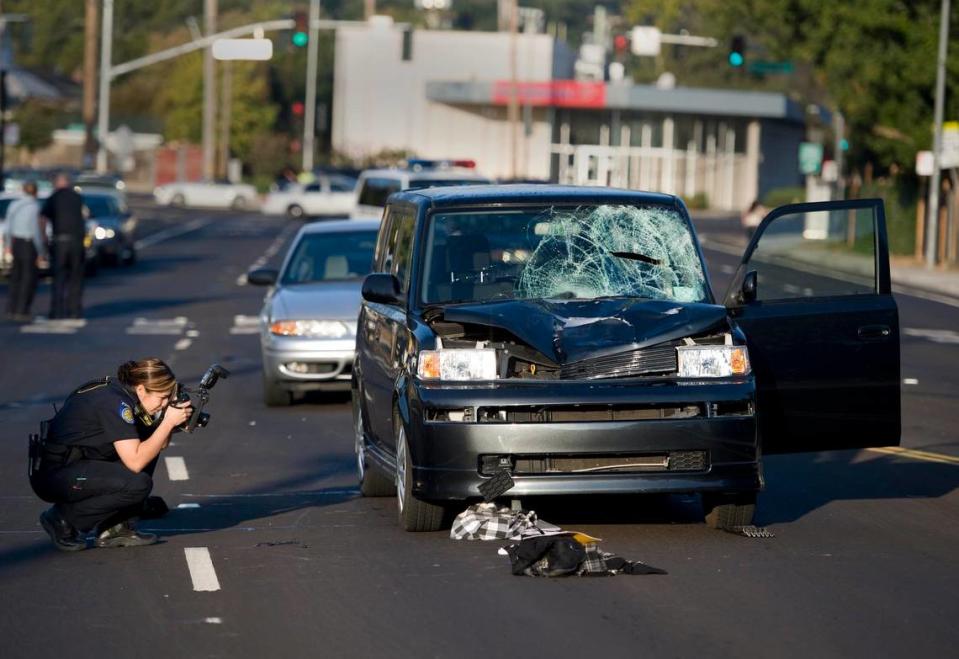
First, they consider whether the signs are adequate; then, the striping on the road; then, potentially, whether they should repaint the striping, or paint a new crosswalk. This all comes before they consider anything more expensive: a speed radar sign, a traffic signal, a raised crosswalk, a pedestrian median island, speed bumps or protected bike lanes.
“After all those plans get approved, which can take years in and of itself, likely, the transportation team then has to go after infrastructure funds,” Moore said, “which is a whole other grant.”
The solutions exist. City staffers know what to do.
But fixing a serious and potentially lethal infrastructure problem is slow in Sacramento.
“It’s such a long process to actually see successful solutions implemented,” Moore said. “And I think that’s the disconnect — community (members) would like to see and really deserve to see those benefits sooner.”
The intersection at Broadway and MLK was, to some degree, fast-tracked through that process, though the current changes still took a year and a half to install.
Edrosolan explained that the city also made smaller improvements before the “road diet” that narrowed the available space for eastbound traffic. The city put in speed radar boards, which research shows have some limited effect on slowing down traffic. The city changed the phasing of traffic signals around the intersection to deter speeding. And city workers pruned trees to improve visibility of signage and traffic signals at MLK.
Even that timeline, Moore said, would not have been possible without a confluence of factors that increased the urgency of the project.
“You have this really high concentration of people getting into crashes at that site,” Moore said. “You have vulnerable populations, with it being a senior living facility. You have the American Legion High School across the street. You have really active and concerned residents.
“So it’s kind of this coalescing of all of the necessary ingredients of severity, frequency, who’s been affected, and the advocacy and the willingness to be engaged in that process.”
Additionally, Edrosolan said, the existing plans to make more permanent changes to Broadway’s infrastructure via the “Complete Streets” project ultimately served as a runway to these interim changes. The quick build was paid for by Vision Zero funds.
Broadway is one of the top five priority corridors in the larger Vision plan, because it has some of the highest numbers of severe and fatal collisions.
Edrosolan said the smaller fixes are “a first step, doing the quick build in lieu of the larger project that’s coming in the future.”
And the changes did come quickly, after all that planning. Edrosolan said they built it out over the course of a single weekend in May.
“It feels fantastic to get this implemented,” he said. “It’s definitely a win-win for for everyone, and not having any collisions? I’m quite happy about it.”
A family torn apart by a dangerous road
San Juan Road has that longer-term, more expensive plan to install a pedestrian median with a warning light but not a stop light — a plan that neighbors said does not change nearly enough. Talamantes has secured the final piece of funding necessary to start the planning and permitting process. Regardless, in the months since the May crash, the road has yet to see any holdover project. And Rayshawna “Shawna” Armstrong’s sister has taken notice.
A few weeks after the fatal crash, Armstrong’s family went to the young woman’s high school graduation. Armstrong had struggled in school as a teen, but she was finally set to graduate in June. Instead of cheering for her as she accepted the Highlands Community Charter School degree she had worked so hard for, Armstrong’s mother, her niece and her surviving child, Lajayla, then 6, walked onto the stage and received the diploma.
It felt so unfair, said Keyona Travis. Her sister’s life was just coming together, “like a puzzle.” Now, it was gone.
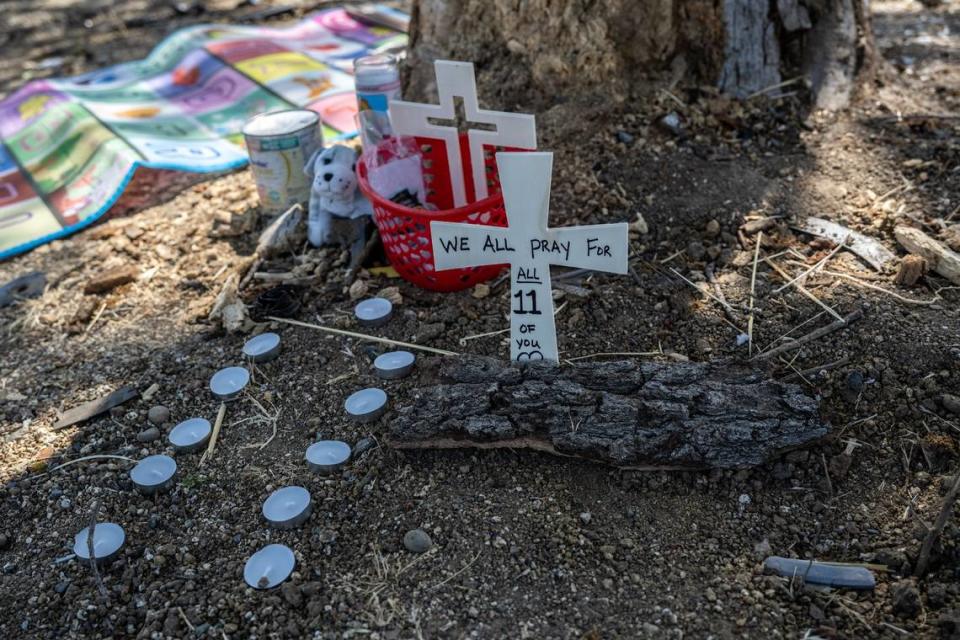
“I thought that was kinda crazy,” she said, “that when her life was actually getting better, her life, basically, was taken.”
Travis is eight years older than Armstrong, and so the two weren’t particularly close growing up. The sisters became deeply intertwined only in the last few years.
She remembered the two of them, just a few weeks before Armstrong died, driving in the car and singing with abandon. Armstrong had a beautiful voice, Travis said, and loved to sing. It was a little thing, but Travis cherishes the memory.
“That was our best sister moment ever, just being in the car, singing together,” she said. “Just enjoying ourselves.”
They had so many plans. Armstrong wanted to walk under the bright lights of Las Vegas with her big sister. The pair wanted to take their children to see San Francisco.
Instead, Armstrong died on the side of a road that officials were warned about years ago. Her son, Zayden, died in the hospital not long after the crash. Travis had to help explain death to Armstrong’s then-6-year-old daughter, who didn’t seem to fully understand, at first, that she couldn’t be with her mother anymore. Her mother was gone. So was her baby brother.
Armstrong and her sister had been raising their kids side by side. In a way, she said, she thought of Zayden as her own son.
Before the crash on San Juan Road, the sisters used to imagine what he’d be like in the future — this smiley, squirmy, bright-eyed little boy.
He never turned 4.

